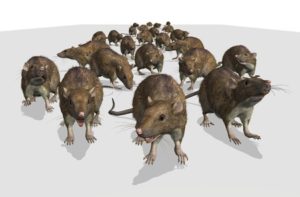 The first step to ensure safety from rodent-borne disease is to have a basic knowledge of what they are, there features, modes of infestation, the diseases rodents can transmit to humans and the possible modes of transmission. Then secondly, know the various means rodents can be eliminated from homes to avoid severe infestations and spread of diseases.
The first step to ensure safety from rodent-borne disease is to have a basic knowledge of what they are, there features, modes of infestation, the diseases rodents can transmit to humans and the possible modes of transmission. Then secondly, know the various means rodents can be eliminated from homes to avoid severe infestations and spread of diseases.
Rat and mouse are rodents. Some of the common species of commensal rodent are:
Rattus norvegicus (Rn), sewer rat; also known as norway rat.
Rattus rattus (R2), house rat; also known as roof rat.
Mus musculus (Mm), mouse.
Rodents have some special features as follows:
They are social animals, nocturnal, good climbers (especially for Rattus rattus), good jumpers, range of movement: 30-50m for rats, 5-10 m for mice, good swimmers and they can dive, rats take 15-30 gm food and consumes about 30 gm water daily, mouse takes only 3 gm of food and small amount of water every day, about 5-8 liters per year, 5-14 per litter and average life span is 1 year.
Rodent-borne Diseases
Rodents are carriers of viral, rickettsial and bacterial diseases. The causative agents could enter our body by four different ways:
1. Through the ecto-parasites of rat like fleas, ticks and mites
2. By food or water contaminated by rodent excreta
3. Through direct contact with rodent excreta
4. By rat bite
Some of the common rodent-borne diseases are:
Plague
This is a disease of rodents caused by the bacterium, Yersinia pestis. Rat fleas feeding on a bacteria-infected rodent would transmit the disease to the next host (rat or human) through biting.
Urban typhus
This is a rickettsial disease transmitted by rat fleas. Flea feces are rubbed or scratched into the wound or abraded skin. Also, possible transmission could be by the inhalation of dust or ingestion of food contaminated with flea excreta.
Spotted fever
This is yet another rickettsial disease transmitted by rickettsia-infected ticks feeding on human through biting. It is transmitted when tick’s larvae feed on rodents; adults feed on dog as their host and then through human contact with the host animals.
Scrub typhus
Also, a rickettsial disease transmitted by rickettsia-infected mites feeding on human through biting. This disease is transmitted by mites amongst rodents in scrubby areas and then accidental infections occurs in man: campers, hikers etc.
Personal Preventive Measures for Scrub Typhus While Hiking/Camping
– Wear long trousers and clothes with long sleeves
– Avoid resting in scrubby area or on grasses
– Apply insect repellents to exposed skin surfaces
– Do not leave clothes in scrubby area or on grasses
Hantaan disease
A disease of rodents caused by Hantaan virus, transmitted by air-borne droplets and fecal particles of infected rodent under poor ventilation.
Rat-bite fever
A bacterial disease from rodents usually transmitted to human through rat biting
Rodent Prevention and Control
1. Direct disinfestations
Use poisonous bait or traps by mixing rodenticide with bait for rodent consumption. Some of the rodenticides are chronic anti-coagulants (vitamin K as the anti-dote). The anti-coagulants take 4-5 days to give effects
Also, consider making Traps for example, Cage trap, Snap trap/break back trap etc.
The use of glue traps can scare rodent that are caught live and cause them to urinate. Since their urine may contain germs, this may increase the risk of being exposed to rodent-borne diseases
2. Fundamental control
– Improve the sanitary condition of the environment and deprive rodents of :
– Food, Harborage and Passages
– Eliminate harborages for rodents and confine the rodent activity area for enhancing the rodent disinfestations work
– Disposal of dead rodents
The following procedures can be used for handling dead rodents found:
Using tools such as tongs to put the dead rodents into a tough plastic bag (e.g. rubbish bag); spraying the carcasses with general household disinfectant or diluted bleaching solution until they are soaked thoroughly; sealing the bag tightly and placed it into another plastic bag. The second plastic bag should also be sealed; putting the bagged material properly in covered rubbish bin or disposing of it to the nearest refuse collection point.
When handling dead rodents, attention should be paid to personal and environmental hygiene. Wear gloves and face mask, if necessary, when handling dead rodents and avoid direct contact with them. All areas, clothes and items contaminated by the dead rodents should be disinfected thoroughly using general household disinfectant or diluted bleaching solution. Before taking off gloves, wash them with water and then cleanse with general household disinfectant or diluted bleaching solution. Hands should be washed thoroughly with soap and water after removing the gloves.

